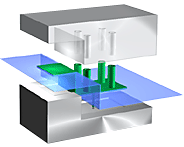A cooling plane needs to be created before you can model any part of a cooling circuit.
Cooling planes are always created parallel to the X-Y plane.
Since a mold must contain both a cavity and core, there may be a small gap between them. While this gap is too small for material to flow into, it still acts as a partial barrier to heat transfer. To simulate this effect, you need to model the surface between the cavity and core as a parting plane.

A parting plane represents the resistance of heat transfer across a surface inside a mold, usually where the two halves of the mold meet. By default, the solver assumes perfect conductivity between mating surfaces. Thermal interface conductance is the only attribute that can be specified as a parting plane property. If a parting plane has low contact pressure or a small gap, and it is located between the part and the cooling channels, it should be modeled.
 Bottom View to display the model in the best orientation for working with cooling planes.
Bottom View to display the model in the best orientation for working with cooling planes.  (
(